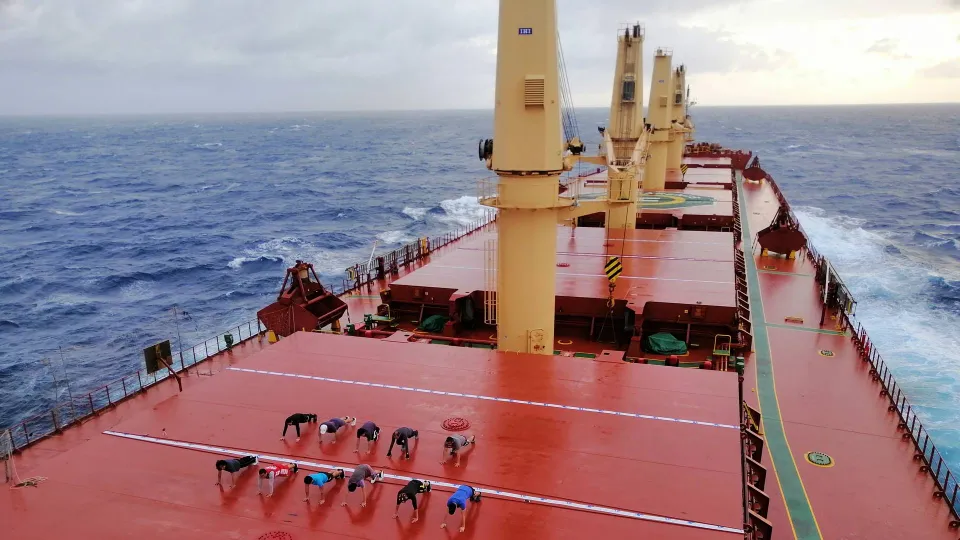Dry bulk and tanker carrier Norden is increasingly committed to using biofuels. However, the company’s Head of Logistics and Climate Solutions admits to WPO that this is a temporary solution on the road to net zero emissions. Sourcing biofuels may prove a challenge.
Looking five years ahead, shipping company Norden’s envisions that at least 50 of the more than 500 ships it owns or operates will run on sustainable biofuel.
As early as this year, half of Norden’s own ships – 15 out of 28 – will fill their tanks with this type of fuel when calling at major European ports, says the company’s Head of Logistics and Climate Solutions Adam Nielsen in an interview with WPO.
Norden has just launched a venture into second-generation biofuel based on recycled cooking oil. Nielsen describes it as a sustainable alternative to bunker oil, and a key advantage is that the fuel can be used with ordinary ship engines.
”We can use it in existing machinery, and we can start today. It’s a good way to make the fleet more climate efficient. We can already do a lot here and now to minimize our fossil fuel consumption,” he says.
Initially, Norden’s ships will be filled with biofuel in Europe, and the carrier has already secured agreements with suppliers at major European ports. Later, it will expand the use of this type of fuel to major ports in North America and Asia, so that at least 10 percent of the fleet will be able to sail on it in five years.
We are targeting the 10-15 largest bunker ports where there will be a degree of supply security
Adam Nielsen, Head of Logistics and Climate Solutions, Norden
”We are targeting the 10-15 largest bunker ports where there will be a degree of supply security. In the smaller places, you won’t always be able to find that kind of fuel,” says Nielsen.
Wood products and sludge
Norden – in close cooperation with the Mærsk Mc-Kinney Møller Center for Zero Carbon Shipping – has been testing biofuels for several years and obtained the necessary approvals.
According to Nielsen, it will eventually be possible to use around 20 different types of waste products for biofuels – such as wood products and sludge – but right now, the basic element consists of residues from cooking oil.
That in itself can be a problem because the volume of cooking oil waste on the world market is not unlimited. Other shipping companies with large fleets are also turning to biofuels, and experts have warned that demand could very easily exceed supply.

Maersk Chief Executive Søren Skou has previously said that ”the problem is that the world doesn’t eat enough french fries [so] we can’t keep scaling it [biofuel, -ed.].”
Furthermore, the war in Ukraine has complicated the supply situation, as the country is a major supplier of sunflower seeds, one of the main sources of cooking oil.
”Getting the biofuel where it is”
Nielsen acknowledges that the use of waste products presents a number of challenges, not least because of supply security. He stresses the importance of ”getting the biofuel where it is.” In other words, it is crucial that the source of the fuel is available near the major ports Norden is banking on.
In the long term, he does not see biofuel as an all-encompassing solution to shipping’s quest for green energy, but he does consider it an important step on the road to even greener energy sources.
Nielsen definitely prefers biofuel to the less climate-friendly liquefied natural gas (LNG), which some shipping companies are examining as an interim solution. And he has full confidence that major bunker ports will be able to supply the fuel when required.
Further down the line, shipping will turn to a much wider range of green fuels such as ammonia. As with access to the right biofuel ingredients, location will be crucial here, too.
”A country such as Japan has a big focus on green ammonia, not least because their power plants are going to use it. It won’t be the same elsewhere,” he predicts.
Net zero by 2050
Norden has formed a climate strategy based on five goals. The carrier’s fleet must be green by 2030, and 20 years later, the company must achieve full net-zero emissions.
It is too early to say which long-term solutions Norden will choose for its vessels to achieve this goal. But for now, the carrier is focusing on biofuels, partly to meet its own climate targets and to meet customers’ demands for more sustainable transport solutions.
”We want a dialogue with customers, so we can help them reduce their emissions,” says the Head of Logistics and Climate Solutions, stressing that a green profile is very much a competitive parameter for shipping.
Large customers such as IKEA took the lead in demanding carbon-neutral solutions, and that has spread
Adam Nielsen, Head of Logistics and Climate Solutions, Norden
”Large customers such as IKEA took the lead in demanding carbon-neutral solutions, and that has spread. Highly polluting industries like mining and cement factories are also well ahead, demanding climate-friendly transport,” he points out.
Looking ahead, Nielsen predicts that there will be significant developments in ship designs over the coming decades.
”Ideally, a ship’s engine should be able to run on several different types of fuel, and that presents some design challenges. It’s too early to say where things will end up, but we are following matters closely because there are some tough decisions to be made,” Adam Nielsen notes.






